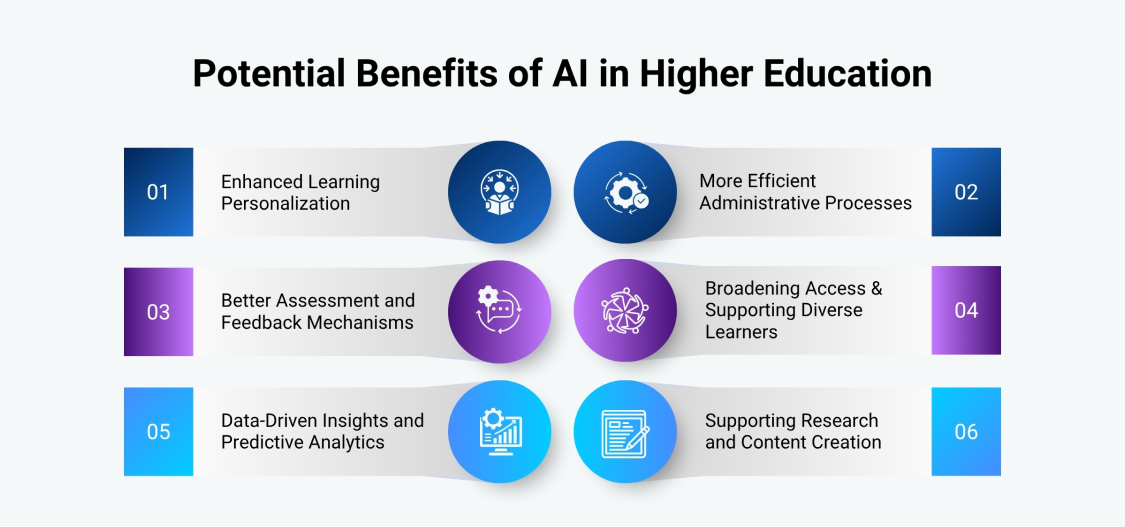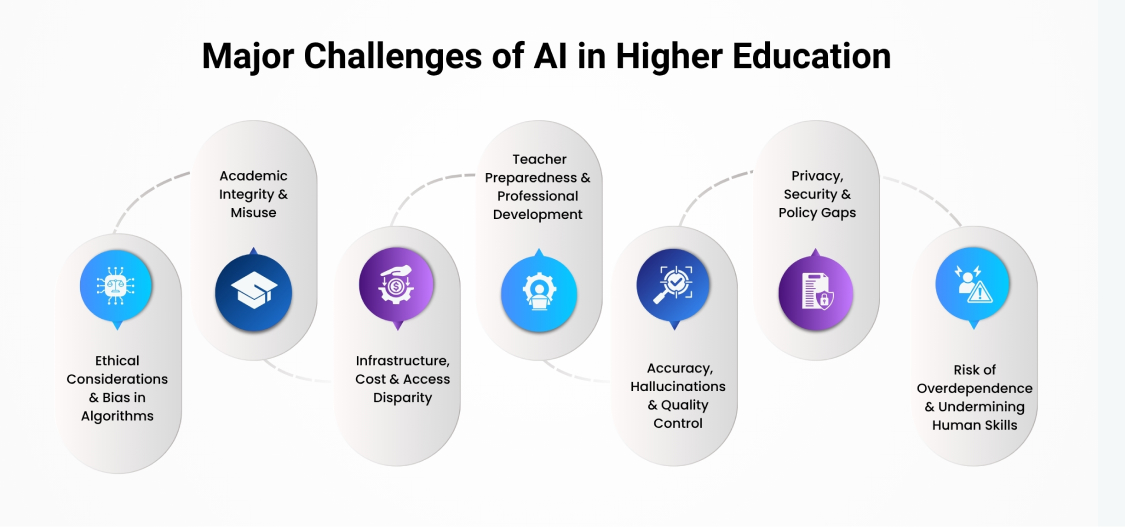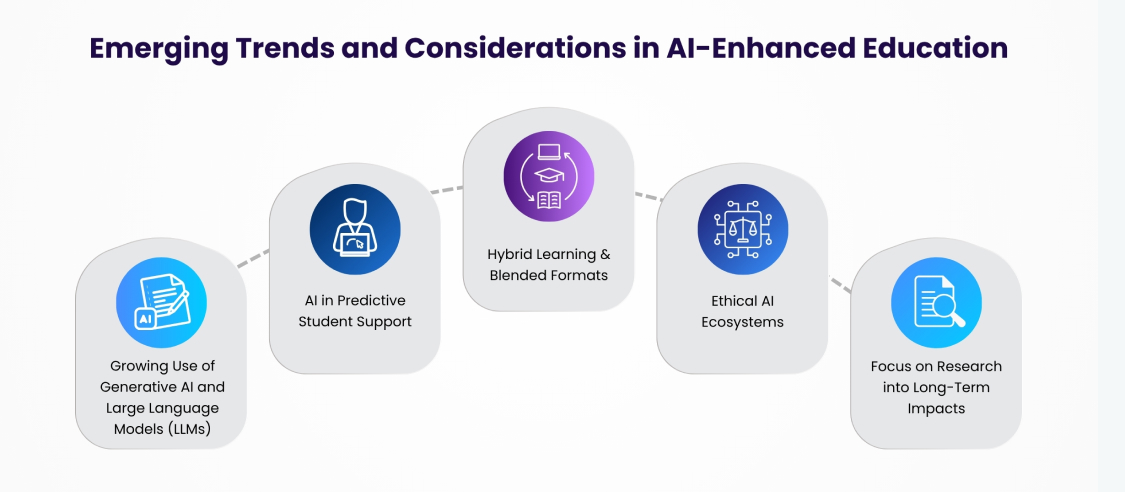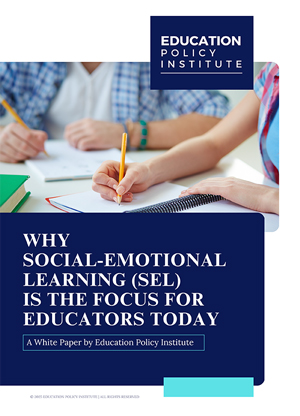Artificial Intelligence (AI) is significantly reshaping higher education, offering both exciting possibilities and serious obstacles. On one hand, AI promises to enhance learning, streamline administrative tasks, and broaden access. On the other, it raises concerns about fairness, privacy, over-dependence, and infrastructure. This article explores key benefits, followed by the main challenges and how institutions might respond to ensure ethical and effective use.
Potential Benefits of AI in Higher Education
Artificial intelligence is increasingly being used in universities to improve learning, streamline processes, and provide new opportunities for students and faculty. Its applications touch both academic and administrative areas, creating space for more efficiency and inclusivity.

1. Enhanced Learning Personalization
AI can adjust study materials to each student’s pace, skill level, and interests. Adaptive systems highlight weak areas and provide additional resources, often leading to stronger engagement and academic improvement compared to uniform teaching methods.
2. More Efficient Administrative Processes
Routine tasks such as grading basic assessments, scheduling, or handling FAQs can be managed by AI, freeing staff for more meaningful work. It is evident that educators save significant time on planning and administration with AI support.
3. Better Assessment and Feedback Mechanisms
Automated grading and feedback tools deliver quick responses on writing, grammar, or structure, letting instructors focus on higher-level evaluation. AI-generated insights also reveal patterns of misunderstanding, aiding curriculum refinement.
4. Broadening Access & Supporting Diverse Learners
From translation tools to adaptive interfaces, AI expands accessibility for learners with disabilities, language barriers, or remote locations. Many educators view these tools as promising for extending quality education to under-served regions.
5. Data-Driven Insights and Predictive Analytics
By analyzing grades, engagement, and attendance, AI can identify students at risk of dropping out and suggest interventions. It also helps measure teaching effectiveness and guide institutional decision-making.
6. Supporting Research and Content Creation
AI assists in scanning literature, drafting summaries, suggesting references, and even shaping course design. This reduces time spent on preparation, allowing academics to focus on creativity, mentoring, and deeper student engagement.
Major Challenges of AI in Higher Education
While the benefits are significant, many challenges complicate the implementation and scaling of AI in higher education. Institutions must address these to avoid unintended harm.

- Ethical Considerations & Bias in Algorithms
AI systems are trained on historical data. When those data reflect social inequities, biases can be built into the system. For example, predictive models might disadvantage certain demographic groups if the training set underrepresents them. Transparency in how algorithms make decisions is often limited, which increases risk. Studies also raise concerns about misuse of student data, lack of consent, or opaque data handling processes.
Read more: AI in Education: Considering the Ethical Dimension
- Academic Integrity & Misuse
Generative AI tools make it easier for learners to produce work without full authorship, raising questions about what counts as original work. Detection tools are imperfect. There is also tension between encouraging creativity and preventing dishonesty. Many educators express concern over how to define acceptable AI use in writing or assignments.
- Infrastructure, Cost & Access Disparity
Reliable internet connectivity, modern hardware, software licenses, and ongoing maintenance are necessary for effective AI deployment. But many institutions, particularly those in lower-income or remote areas lack such resources. This disparity can widen educational gaps rather than close them. Moreover, cost is not only financial but involves technical expertise, training and support.
- Teacher Preparedness & Professional Development
Many faculty and staff lack prior exposure to and training in AI tools. Without confidence and know-how, there is risk of misuse, overreliance, or simply low adoption. There is also apprehension about job roles, and whether AI may reduce human involvement. Significant training is required, including understanding of limitations, ethical implications, and working with AI outputs critically.
Read more: A Guide to Teacher Professional Development
- Accuracy, Hallucinations & Quality Control
AI shows varying levels of performance. Sometimes output is incorrect, oversimplified, or misleading. “Hallucination,” where generative tools produce plausible but false information, poses a real risk. Ensuring content quality, verifying sources, and confirming reliability are necessary steps. Institutions envision checks and human oversight as essential.
- Privacy, Security & Policy Gaps
AI tools require large amounts of data. That raises issues around who owns data, how it’s stored, who can access it, and for what purposes. Privacy laws differ by region. Many students and educators are concerned about data misuse or lack of clarity on how their information is handled. Proper policy frameworks are often lacking or still under development.
- Risk of Overdependence & Undermining Human Skills
If students rely too heavily on AI for critical thinking, creativity, or research skills, those skills may atrophy. Learning is more than output generation, it involves struggle, questioning and failures. Interaction with instructors and peers, debate, and error correction are fundamental. There is concern that AI-led shortcuts might reduce deep engagement with material.
Balancing Opportunities and Risks: Institutional Strategies
For institutions to benefit ethically and sustainably from AI, several strategies need to be implemented.
- Establish Clear Policy Frameworks: Institutions should define acceptable use cases for AI, data governance, privacy standards, and rules regarding academic integrity. Decision-makers must ensure transparency in how AI tools make suggestions or grading decisions.
- Promote AI Literacy for Faculty and Students: Both teachers and learners need training, not just on how to use tools, but on understanding their limitations, ethical concerns, and how to critically evaluate outputs. Encouragingly, positive attitudes toward AI among faculty increase when training is supplied.
- Inclusive Access & Infrastructure Investment: Ensuring stable internet, up-to-date devices, software resources, and support are essential, especially in regions or institutions with fewer resources. Partnerships, grants, or shared platforms can help bridge gaps.
- Maintain Human Oversight in Assessment & Feedback: Use AI to support, not replace, human judgment in assignments requiring critical thinking, creativity, morality, or ethical reasoning. Hybrid models, where AI handles routine tasks and humans mentor, review, and critique, appear promising.
- Ensure Data Security & Ethical Standards: Strong protocols for data protection, policies for consent, anonymization where possible, and regular audits of AI systems to detect bias or misuse are necessary. A nascent body of research indicates that transparency and ethics built in from the beginning reduce risk.
Emerging Trends and Considerations in AI-Enhanced Education
AI is set to reshape the future of education, offering new ways to support students, enhance learning experiences, and streamline teaching processes.

- Growing Use of Generative AI and Large Language Models (LLMs): Educators are increasingly familiar with generative tools, and many view them positively for helping in concept explanation, drafting content, or brainstorming ideas.
- AI in Predictive Student Support: More institutions are exploring early warning systems that use AI to detect students who might be at risk of failing or dropping out. These systems rely on combining multiple sources of data: grades, attendance, engagement metrics and more. The challenge is developing models that are accurate, fair, and transparent.
- Hybrid Learning & Blended Formats: The combination of in-person and AI-assisted learning is becoming standard. AI may be used to supplement lectures with adaptive modules or to allow students to engage asynchronously, leaving face-time for discussions, critiques, and mentorship.
- Ethical AI Ecosystems: There is increasing interest in ensuring that AI tools are developed and used with ethical principles in mind such as fairness, inclusion, accountability, transparency. Tools that explain their own reasoning, systems that allow user input in setting constraints, and oversight bodies are likely to become more common.
- Focus on Research into Long-Term Impacts: While short-term benefits like engagement or efficiency are visible, there is still limited data on long-term outcomes like critical thinking ability, retention, inequality in educational success and psychological effects. More longitudinal studies are needed.
Conclusion
AI offers a powerful opportunity to reshape higher education by enabling personalized learning, improving efficiency, expanding access, and providing data-driven insights that were once difficult to achieve. However, these benefits are not guaranteed, as challenges related to ethics, bias, infrastructure, overreliance, academic integrity, and privacy must be addressed with care. Institutions that thrive will be those that invest not only in technology but also in human capacity, governance, and equitable access, ensuring that AI supports rather than replaces human expertise. By preserving the core values of higher education, such as critical thinking, mentorship, interaction, and ethical responsibility, the sector can harness AI’s potential while minimizing risks, ultimately determining whether it drives inclusive progress or deepens existing inequalities.





